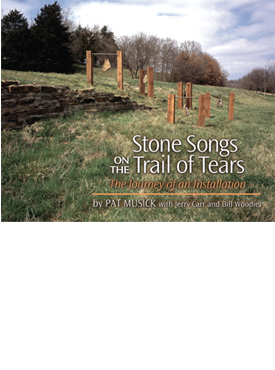In March 2002, artist Pat Musick, her husband, Jerry Carr, and historian Bill Woodiel set out to commemorate a portion of the great and tragic Trail of Tears. On the Trail of Tears, the Cherokees, among other American Indian tribes, were forced to migrate westward, leaving their homelands for the unknown.
Following the tradition of Christo, and inspired by installation artist Andy Goldsworthy, Musick and crew created an art installation titled Stone Songs on the Trail of Tears. This book chronicles the journey, with photographs, poetry, maps, journal entries, and introductory essays on art and history.
It is an eye-catching piece of art featuring five yokes that combines oak, wood, steel, and native Ozark sandstone, designed to represent the struggle of those who took the brutal journey. The installation traveled to twenty-two stops along the Benge Route across northern Arkansas, the actual route taken by some of the Cherokees in 1838. Musick and her crew moved the installation to each spot along the Trail of Tears; sometimes using the wagon ruts or other physical remains still present to guide their way. Time was spent in each area, meeting locals, setting up, photographing, and moving on, as ephemeral as the Cherokee’s journey itself.
According to Musick, “The project became much more than any of us expected. About the second day the sculpture took on a life of its own, and we viewed it as ‘moving’ through the trail sites. Each of us experienced poignant identification with the tragic history of ‘the People.’
We felt that ‘Nunahi-Duna-Dlo-Hilu-I,’ the ‘place where they cried’ had changed our lives forever.” Each photograph is accompanied by a poem written by Musick in the voice of a young Cherokee mother making the journey.
Stone Songs on the Trail of Tears: The Journey of an Installation is a beautiful and powerful portrayal of the strength, courage, and perseverance of the Cherokee people. It is more than just a book; it has become a documentary piece of history. Donald Harington, noted author and University of Arkansas professor of fine arts, contributes an introductory essay, as do historian Bill Woodiel and Jack Baker, president of the National Trail of Tears Association.
Stone Songs on the Trail of Tears
$32.95
The Journey of an Installation
Mat Musick, with Jerry Carr and Bill Woodiel
978-1-55728-800-4 (cloth)
October 2005
Pat Musick’s unique work combines her intimate knowledge of nature and her urge to create, producing works with a harmonious blending of shape, material, and color. Her installations have been shown throughout the United States, particularly in the Southeast, where many can be found on permanent display. She lives in the seclusion and natural beauty of the Ozark Mountains in Arkansas with her husband, Jerry Carr.
Jerry Carr is a retired NASA astronaut who commanded the eighty-four-day Skylab IV mission. He took over two thousand photos using a Hasselblad camera similar to the one used to photograph Yokes. Since the early 1980s, he has also documented all of Musick’s work. He photographed the Yokes sculpture at more than fifty sites, from which twenty-two were selected to be in the book.
Bill Woodiel is a historian and former high-school history teacher from Mountain Home, Arkansas. For the past ten years he has researched and found many sites along the Cherokee Trail of Tears. A past vice-president of the Arkansas chapter of the Trail of Tears Association, he was an invaluable resource and adviser to Musick and her crew.
“Artist Pat Musick has found inspiration and opportunity for great art in what has been recorded only in legendary accounts of the Cherokee Trail of Tears. Pat Musick’s sculpture and Jerry Carr’s photographs have recorded routes and places that give a unique ‘thereness’ to this tragic bit of American History.”
—Charles Banks Wilson, Oklahoma artist, portrayer of the Western and Plains Indians
“The Trail of Tears sculpture represents the suffering and the agony of the Cherokee people as they were removed from their Eastern homelands. The story reflected in the sculpture warns the American public that a nation founded on the principles of equality can fall prey to greed and racism and cautions us to ever be vigilant to prevent such an event from happening again.”
—Jack Baker, president of the National Trail of Tears Association
“Pat Musick’s Stone Songs on the Trail of Tears suggests not only the literal burdens that the Indians carried on the Trail but the spiritual burden of psychological scars that resulted from the loss of everything familiar, dear and sacred as well as the terrible burden of history that the dark days of the removal represent to the tribes today. The burden does not belong only to those whose family stories keep it alive. It is a burden that American society must also bear. It behooves us not only just to tell the story but to tell it as truthfully, as accurately and as well as we can—through our literature and our history—and to interpret it as sensitively as we can in our art, as Pat Musick has done.”
—Dan Littlefield, president of the Arkansas Trail of Tears Association

